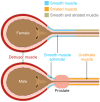ACVIM consensus statement on diagnosis and management of urinary incontinence in dogs
- PMID: 38217372
- PMCID: PMC10937496
- DOI: 10.1111/jvim.16975
ACVIM consensus statement on diagnosis and management of urinary incontinence in dogs
Abstract
Urinary incontinence (UI) is a disorder of micturition that can occur in dogs of any age, sex, and breed depending on the underlying cause and time of onset. Diagnosis and treatment for various causes of UI in dogs have been described by multiple comprehensive single author review articles, but large prospective clinical trials comparing treatment outcomes in veterinary medicine are lacking. The objectives of this consensus statement therefore are to provide guidelines on both recommended diagnostic testing and treatment for various causes of UI in dogs. Specifically, pathophysiology directly related to the canine urinary system will be reviewed and diagnostic and therapeutic challenges will be addressed. A panel of 12 experts in the field (8 small animal internists [L. Adams, J. Bartges, A. Berent, J. Byron, J. Foster, A. Kendall, S. Vaden, J. Westropp], 2 neurologists [J. Coates, N. Olby], 1 radiologist [G. Oetelaar], and 1 surgeon [C. Adin]) was formed to assess and summarize evidence in the peer-reviewed literature and to complement it with consensus recommendations using the Delphi method. Some statements were not voted on by all panelists. This consensus statement aims to provide guidance for management of both male and female dogs with underlying storage or voiding disorders resulting in UI.
Keywords: canine; incontinence; urinary.
© 2024 The Authors. Journal of Veterinary Internal Medicine published by Wiley Periodicals LLC on behalf of American College of Veterinary Internal Medicine.
Conflict of interest statement
Authors declare no conflict of interest.
Figures










References
-
- Arnold S, Arnold P, Hubler M, Casal M, Rüsch P. Urinary incontinence in spayed female dogs: frequency and breed disposition. Schweiz Arch Tierheilkd. 1989;131:259‐263. - PubMed
-
- Thrusfield MV, Holt PE, Muirhead RH. Acquired urinary incontinence in bitches: its incidence and relationship to neutering practices. J Small Anim Pract. 1998;39:559‐566. - PubMed
-
- Forsee KM, Davis GJ, Mouat EE, Salmeri KR, Bastian RP. Evaluation of the prevalence of urinary incontinence in spayed female dogs: 566 cases (2003‐2008). J Am Vet Med Assoc. 2013;242:959‐962. - PubMed
-
- O'Neill DG, Riddell A, Church DB, Owen L, Brodbelt DC, Hall JL. Urinary incontinence in bitches under primary veterinary care in England: prevalence and risk factors. J Small Anim Pract. 2017;58:685‐693. - PubMed
Publication types
MeSH terms
LinkOut - more resources
Full Text Sources
Medical

